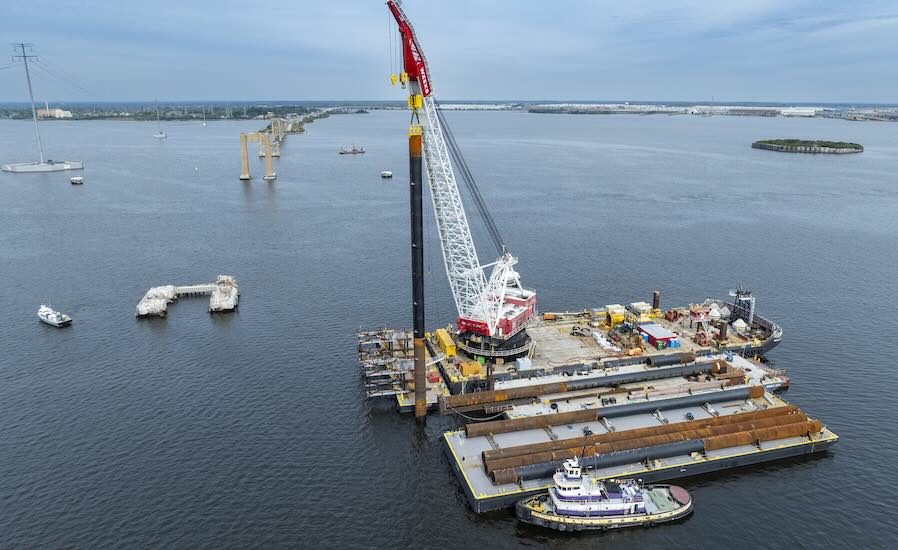Test Pile Program Sets Stage for Key Bridge Rebuild

As the last remaining spans of Baltimore’s original Francis Scott Key Bridge are demolished, a test pile program currently underway is helping shape the foundation strategy for its planned successor structure.
Begun in late September by the Maryland Transportation Authority (MDTA), the program calls for twelve 220- to 235-ft, 8-ft-dia. test piles to be driven into the Patapsco River along the route of a new two-mile-long cable-stayed structure being designed by Kiewit Infrastructure Co. under the $73-million first phase of a progressive design-build contract. Weighing approximately 340,000 lb each, the test piles are being driven using barge-mounted cranes and hydraulic equipment through the riverbed’s approximately 60-ft-deep soft upper layer to an underlying rock strata.
Driven by an estimated 10 million lb of force, the test piles are being hammered even deeper to determine the optimal depth for the new bridge’s permanent foundation piles, MDTA says. Instrumentation installed on the piles is recording how they respond to vertical and horizonal pressure exerted by a 35×35-ft load frame. Bubble curtains adjacent to the test piles mitigate effects from the pile-driving activity on marine life.
MDTA expects the testing program to conclude this month. Some of the test piles may be incorporated into the permanent pilings, installation of which could begin by the end of the year, the agency says. Demolition of the old bridge’s remaining river spans is more than halfway complete, with several structures in the river yet to be removed. MDTA expects that work to be completed by next spring. Earlier this year, the agency announced a shift in the new bridge’s alignment to better facilitate concurrent demolition and new construction activity.
Meanwhile, MDTA reports that design of the new bridge is approximately 70% complete, about the point the agency previously said it would negotiate a final a final guaranteed maximum price and schedule with Kiewit. Previous reports estimated the new crossing would cost $1.8 billion, with completion scheduled for fall 2028. MDTA representatives have told local media that the agency is moving at “breakneck speed” to replace the original 1.7-mile steel bridge, which collapsed after being struck by the disabled container vessel M/V Dali on March 26, 2024. The National Transportation Safety Board will hold a public meeting Nov. 18 to determine the probable cause of the incident, which killed six construction workers.
Although then-President Joe Biden promised full funding for a new Key Bridge, the Trump Administration has been less receptive to Maryland’s policy of having at least 26% participation by minority, women, and veteran-owned businesses on contracts of more than $100,000. In a letter to Gov. Wes Moore (D) this past September, Secretary of Transportation Sean Duffy wrote that contracting decisions based on “race or sex conscience factors” could introduce significant legal vulnerabilities and inefficiencies in the management of the project, putting federal funding support at risk.
Along with highlighting the important role the Key Bridge crossing plays in both the state and national economy, Moore promised to continue collaborative efforts “to find ways to reduce costs and rebuild faster.”
Maryland is also pursuing litigation against the Dali’s owners and operators for compensation that it says will help offset the cost of constructing the replacement structure. The first trial date, in which a federal judge will begin the process of determining whether the Dali’s owner, Grace Ocean Private Ltd., can limit its liability for the incident under maritime law, is scheduled for June 2026.
The post "Test Pile Program Sets Stage for Key Bridge Rebuild" appeared first on Consulting-Specifying Engineer

